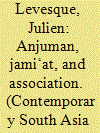|
|
|
Sort Order |
|
|
|
Items / Page
|
|
|
|
|
|
|
| Srl | Item |
| 1 |
ID:
193293


|
|
|
|
|
| Summary/Abstract |
In the early decades of the twentieth century in colonial India, the development of education, the expansion of electoral politics, and the decennial censuses led many caste communities, or ‘caste groups’, to organize collectively in search of internal solidarity and public assertion. Informed by the notions of service and reform, Muslims participated in this new associationism. Among them, the Sayyids – a privileged status group that claims descent from Prophet Muhammad – also formed their organizations. This article compares three Sayyid organizations in India and Pakistan, with two principal aims. First, it brings out the implicit notions of inclusion and exclusion that inform the functioning of the organizations as they seek community preservation. Second, it draws broader conclusions about associational forms available to South Asian Muslims when they act collectively on the basis of a shared social status or caste. The article concludes by delineating three ‘organizational models’ that Muslim caste groups can draw upon – the anjuman, the jami‘at, and the association. Overall, this article illustrates how Muslims frame practices of social distinction in an Islamic language of equality, piety, or service.
|
|
|
|
|
|
|
|
|
|
|
|
|
|
|
|
| 2 |
ID:
144724


|
|
|
|
|
| Summary/Abstract |
Rebellions bringing together peasant-pastoralists, local dignitaries, and a few Sayyids prevented the Safavid monarchs from effectively controlling the political and economic activities in the province of Astarabad until the late sixteenth century. This paper investigates the nature of these rebellions led by the siyāh pūshān (wearers of black), and the socio-economic background and religious leanings of these rebels and their diverse allies. It also pays special attention to Astarabad's Sayyids, their intellectual formation, and their distinct approaches to the Safavid state from the early sixteenth century until the late 1570s when the uprisings lost much of their vigor. While heterodoxy may have been part of Astarabad's religious landscape, there is no evidence that it had a significant manifestation in the Siyah Push movement. More importantly, urban Shiʿi doctrinal and legal traditions had profound roots in Astarabad, nurtured by the Sayyids and promoted by the Betekchi dignitaries prior to the rise of the Safavids. This is significant given the fact that a group of Sayyids from Astarabad (especially the town of Fenderesk) were directly involved in the insurgency against the early Safavids.
|
|
|
|
|
|
|
|
|
|
|
|
|
|
|
|
|
|
|
|
|